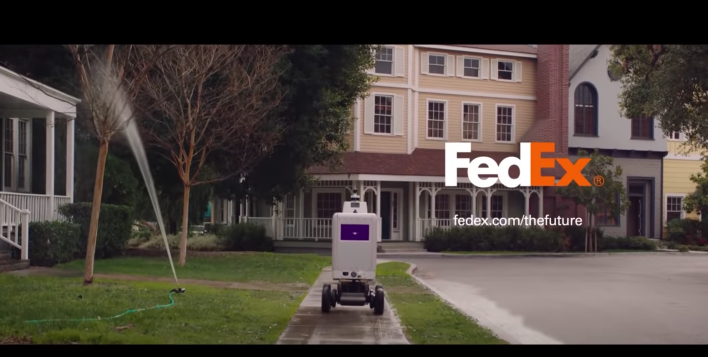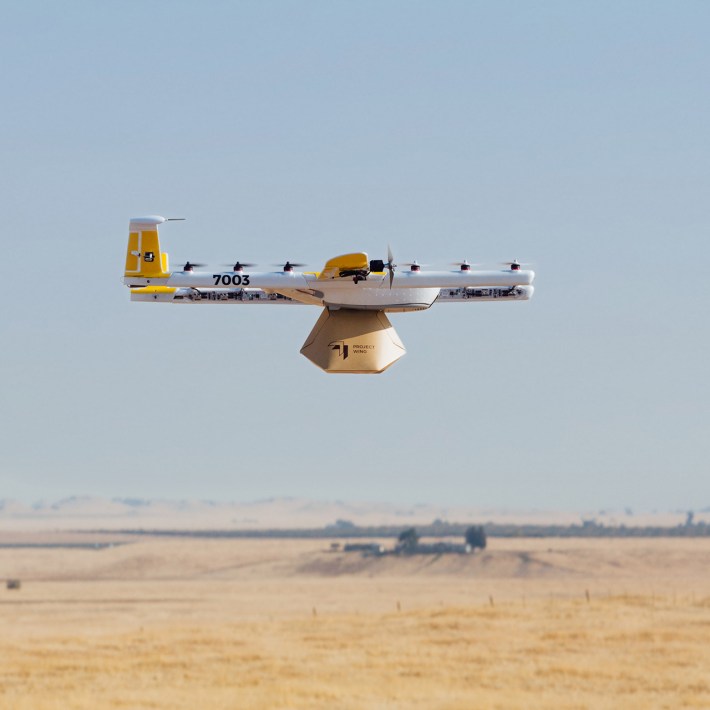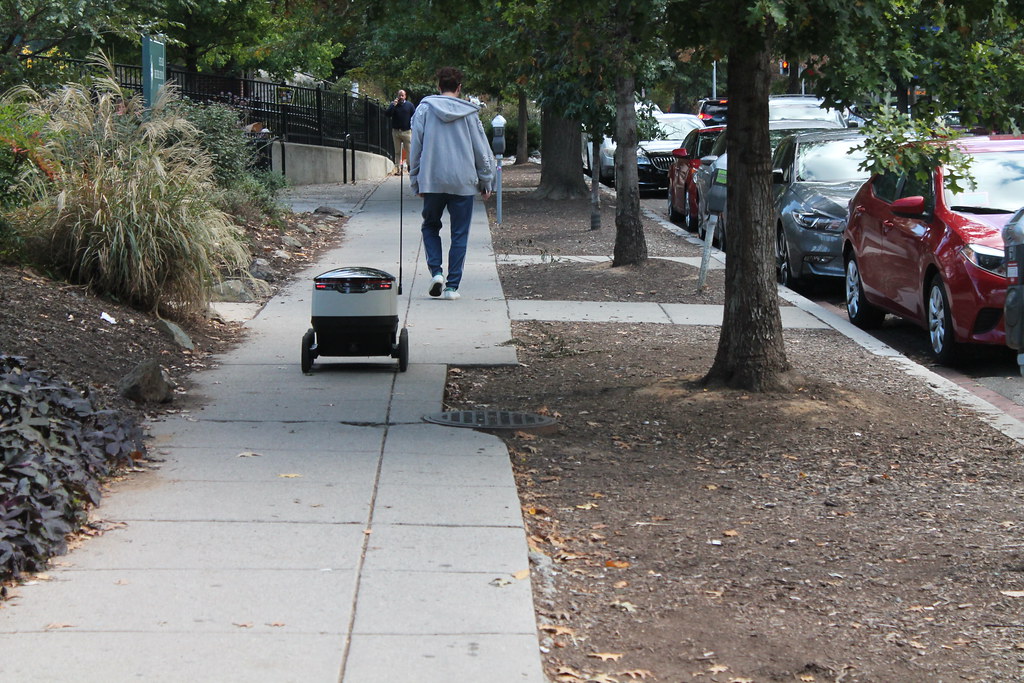COVID-19 may be our best chance to get rid of the dangerous delivery truck once and for all — but safe streets advocates want to be sure that we don't replace it with something worse.
The coronavirus outbreak has added a new dimension to the debate about whether e-commerce is truly safe for society, as delivery drivers fall ill to the pandemic and risk infecting others on the job. But even before we all had to worry about the FedEx guy sneezing on our packages, the car- and truck-based delivery sector has been a scourge to vulnerable road users. It bears repeating: Drivers of heavy trucks kill pedestrians — even if the corporations and businesses that sign their paychecks work hard to obscure the full scale of the carnage from the public. Even just looking at Amazon and Amazon-affiliated delivery drivers paints a grim picture: over 60 of them were found to be responsible for a serious crash, including 10 deaths, on American streets since 2015, a tally that ProPublica says is "most likely a fraction" of the total carnage, since most crash victims don't sue.
Between the viral pandemic and the ongoing pedestrian death pandemic, advocates say it's especially urgent for cities to implement car-free, contactless delivery models at scale. And they're urging agencies and companies from the sky (like the Federal Aviation Administration) to the ground (like FedEx and UPS) to take immediate action.
Meet R2D2 Jr.
But the road to pedestrian-safe driverless delivery won't be easy.
Sidewalk robots, for one, have been widely maligned by safe streets advocates for years for a simple reason: nearly all of of them are sidewalk hogs. Only 10 states allow delivery robots at all — and the R2 units are restricted to the sliver of space currently reserved for walkers.
Proponents argue that droids walk at about human pace and are roughly as wide as a person, so robots don't pose a real obstacle to pedestrians and even wheelchair users on an adequately wide walkway. But of course, not all sidewalks are adequate — and in the age of social distancing, when pedestrians are already jockeying for safe space to get six feet from one another, robots could mean even less access to scarce asphalt.
The solution, of course, is simple: let the robots roll in the street. When car traffic is already historically light and safe streets advocates are desperate for ways to slow drivers down, there's simply no ethical reason not to slap a flag on top of every mini-robot on the road and program it to take the lane. Off-brand Wall-E and his buddies would make even more sense in combination with car-free streets programs like the 74 mile pilot that's currently underway in Oakland; after all, it'd be a lot easier to share a whole, car-free road with a low-speed robot programmed with pedestrian detection technology than to navigate an awkward waltz with an automaton and all your terrified neighbors alongside a rushing river of cars.
"As people are spending more time at home at the moment, including the elderly and more vulnerable, [sidewalk robots can help get] food and groceries delivered straight to their doors," said a spokesperson for Starship Industries, a leading delivery robot manufacturer. "Our robots provide true contactless deliveries."

Of course, R2D2's descendants aren't the only driverless delivery bots in the game, and it's been the subject of controversy since long before the pandemic struck.
Yes, let's talk drones
The delivery drone has been the target of public and federal skepticism for a host of reasons, ranging from the sensible (a low-flying airborne object could, theoretically, hurt a vulnerable road user if it failed mid-flight) to the speculative (no, a 10-pound flying delivery bot is not "just like" a military drone that can surveil your movements and bomb your house from the sky). But in an age where there's a clear incentive to minimize viral risks to human delivery drivers and minimize delivery truck collision risks to pedestrians, there are some compelling arguments that the time for unmanned aerial vehicles has come.
For one: it's already happening. The FAA has been testing unmanned aircraft delivery in Christiansburg, Va. since 2017, and the program has seen a surge of demand in the age of COVID-19 — as well as a surge of media outlets geeking out at the idea of getting toilet paper from a mini-helicopter in under 10 minutes. (In case you didn't know: the humble-looking delivery drone tops out at an impressive 80 miles per hour and is powered by electricity, which makes it substantially more efficient than traditional stop-and-go delivery trucks, in both the environmental and temporal senses of the word.)

Among all the participants in the Christiansburg pilot, Google X's Wing drones have been getting some particular mileage in the media — and they're definitely getting a lot of love from local residents during the age of social distancing. The company has partnered with Walgreens to deliver medicine from the pharmacy and simple food staples from the grocery section. They've also formed partnerships with small local businesses, many of whom have actually seen their revenues rise since the outbreak began.
"One of our companies, Brew Coffee, actually saw a 50-percent sales increase on their first weekend post-lockdown over what they did before COVID-19," said Alexa Dennett, the company's head of marketing and communications. "They simply couldn't serve hot coffee and other goods at that volume without drone delivery right now. That’s the kind of stuff that gets me out of bed in the morning."
Keeping the local economy going through a pandemic isn't the only benefit of drone delivery. Residents who were largely homebound before the COVID-19 crisis, including some elderly and mobility-impaired people who simply aren't always up for a paratransit trip, have reported that drone delivery was a fast, empowering, and inexpensive alternative to the coordinating delivery with relatives and private services. And the benefits of getting dangerous delivery trucks off the road can't be overstated.
"Wing is far safer for society than consumers all hopping in their cars to get something from the shops," said Dennett. "It's safer than ordering from a traditional delivery truck driver, too; that person shouldn't have to risk his or her life."
But the U.S. has been slow to adopt drone delivery, largely due to restrictions from the Federal Aviation Administration over airspace rights. The specific reasons why are a bit of a morass, but basically: airplanes approaching or leaving airports can't see all drones, and vice versa, which could be a recipe for collisions unless we take a few basic legislative steps to ensure aircrafts can safely avoid one another.
Of course, drones also have to overcome their association with dystopian science fiction. But advocates are hopeful that a little public education could bust such stereotypes — and get residents fired up to demand emergency dispensations for drone delivery during the coronavirus outbreak. Google's Wing, for instance, isn't designed for the kind of invasive surveillance that privacy groups fear, since it can only take low-resolution, black-and-white stills to help when GPS navigation fails — and the photos can't even be saved for future use, the company says. All things considered, a standard cellphone camera and microphone probably poses a greater privacy risk to residents.
And some argue the benefits of getting dangerous, high-polluting cars off the road — a technology that we know kills thousands of America every year, both in collisions and as a result of pollution — outweighs the potential risks of a drone being used to nefarious ends.
"We’ve designed our drone with energy efficiency and safety at the forefront, from day one," said Dennett. "A 10-pound drone carrying a 3.3-pound package full of bandages and coffee versus a 2,000-pound car carrying a series of two-pound packages just makes more economic and ecological sense."
It makes road safety sense, too — and it will continue to make sense long after the coronavirus pandemic subsides. The question is whether we'll be able to think big enough as a society to put alternatives to the delivery truck on the road and in the skies, whether we're talking drones, bots, or even, eventually, bike couriers.
"This technology can provide access to food, medication, and other essential goods at a time when people can’t meet in person," said Dennett. "That's huge."






